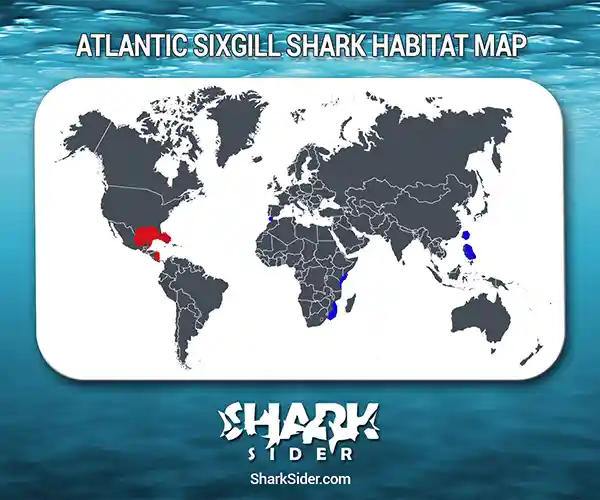The Atlantic sixgill shark is a recently discovered species of sixgill shark. Sixgillsharks belong to the more extensive cow shark family. They are one of the oldest shark species, having evolved over 250 million years ago. However, researchers know little about them as they live in the deep seas.The Atlantic sixgill was initially confused with the more common Bigeye sixgill shark, but DNA tests in 2018 confirmed it as a separate species.
Atlantic Sixgill Shark scientific classification |
|
| Kingdom | Animalia |
| Phylum | Chordata |
| Class | Chondrichthyes |
| Order | Hexanchiformes |
| Family | Hexanchidae |
| Genus | Hexanchus |
| Scientific name | H. vitulus |
Description
These sharks are smaller than other members of their genus, reaching a maximum length of 180 cm (6 ft). They are distinguished from other sixgill sharks by the placement of the dorsal fin.
The species gets its name from its six pairs of gill slits, unlike the five pairs most other sharks have. It has a pointed snout, big green eyes, and five pairs of broad, saw-like teeth on the lower jaw. The upper body is gray with a pale underside. The tip of the caudal fin is dusky or black.
The pectoral fins are small and curved, and the pelvic fins are low and drawn out. A single dorsal fin is placed near the pelvic fins’ rear ends. The caudal fin has a prominent notch on its upper lobe and a pronounced lower lobe.
Where do they live
Map Of The Atlantic Sixgill Shark’s Habitat

The Atlantic sixgill shark inhabits patches in the tropical western Atlantic Ocean. It occurs around Florida, the Bahamas, the Yucatan Peninsula, and the Gulf of Mexico from Nicaragua to Panama. It is a deepwater fish found between 90-620 m (295-2034 ft) below the surface.
Behavior
Dietary
Atlantic sixgill sharks feed on small bony fish and crustaceans.
Reproductive
It follows theaplacental viviparous mode of reproduction. The litter size is unknown, though it is assumed to be large like other species in its genus. Mating is thought to occur year-round, with sexual maturity attained at a length of 140-175 cm (4.6-5.8 ft).
Adaptations
They share many evolutionary traits with other sharks, such as a sharp sense of sight and smell, pointed rows of teeth, and a smooth, streamlined body.
Human interactions
Due to its deep-sea habitat, there are few encounters with humans on record. Commercial fisheries have caught a few species in the Gulf of Mexico. Researchers are planning to conduct more research into its population to assess the threat from deep sea fishing.
The IUCN has listed the Atlantic sixgill shark as “Least Concern” or “LC.”
